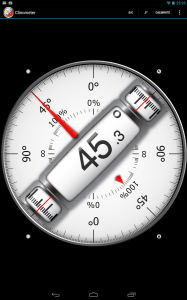 Many owners of Android – devices with a touchscreen display often face a problem when the screen is 'not listening' to them. That is, when you touch the touchscreen with your finger or stylus at one point, the phone perceives it as touching completely at another point. Or, the sensor completely fulfills orders with only 3-4 attempts. And most likely the reason for these problems is the incorrect operation of the screen, and in order to fix it, you need to calibrate the touchscreen of the Android device.
Many owners of Android – devices with a touchscreen display often face a problem when the screen is 'not listening' to them. That is, when you touch the touchscreen with your finger or stylus at one point, the phone perceives it as touching completely at another point. Or, the sensor completely fulfills orders with only 3-4 attempts. And most likely the reason for these problems is the incorrect operation of the screen, and in order to fix it, you need to calibrate the touchscreen of the Android device.
Touchscreen calibration Android: Video
to the content
What it is?
Screen calibration is setting up the touchscreen to correctly execute commands when you touch it with your fingers or stylus. Of course, you can work with your device without such a setting, but then get ready to waste your nerves, time and other troubles.
This procedure is required in most cases after the phone has been dropped, especially in water. Replacing the screen, the water stain under it, even the smallest damage may require urgent adjustment. Checking if you need calibration is as easy as shelling pears. First, remove the protective film to make the sensor work as clear as possible, then just enter any number or letter. If you have chosen, say 'B', and 'A' appears on the screen, then be sure – you need to configure the touchscreen.
There are two main types of screens used in the production of Android devices: capacitive and resistive. Capacitive is now used in the absolute majority, since it is more reliable and of high quality. But with resistive, problems often arise, and it requires tuning more often. But the good is that now these are rarely used – only in outdated or budget models.

to the content
Sensor calibration Android: programs, setting: Video
to the content
How do I calibrate the screen on Android?
There are two main ways to tidy up a broken touch sensor – special programs and with your own hand. You should also remind you that for HTC, Samsung, Nokia and other Android devices, the calibration procedure is almost identical. You can also see how to set up auto-rotate screen.
to the content
Setting using special programs
In the free, and most importantly – in the free, access, you can find a lot of software for screen calibration. They are easy to install, easy to operate and, what is important, they give results. For example, Clinometer, TOPON, Bubble – just take a look at Google Play. But? even if you don't have access to Google Play, you can adjust the display without it using the second method.

to the content
Self-configuration
In order to independently adjust the touchscreen Android 4 (or another version) without any problems, we will present you with step-by-step instructions:
- The first step, of course, is to navigate to the 'Settings' menu.
- Next, select 'Phone Settings'.
- We find the item 'Calibration' and a cross-target with a dot inside will appear in front of you.
- We make money in the center of the target several times (3 will be enough).
- After that, your device will remember the touches and the calibration can be considered complete.
- After finishing the adjustment, check the sensor operation. If exactly the symbol that you clicked appears on the screen, then everything is done correctly. Congratulations! (How to reset settings)
to the content
Adjusting Touch Screen Sensitivity on Android: Video
to the content
Contacting the service center
Now you know two ways to independently calibrate the screen on your Android – device. But there is also a third option for setting up your device – this is an official or private service center. It would seem, why turn to the master for such a trifle? But this problem is not always a trifle. It happens that the cause of the breakdown is not in the knocked down settings, but in a serious breakdown or in the factory marriage of the display. In this case, it is really better to contact the service if the first two did not work.
